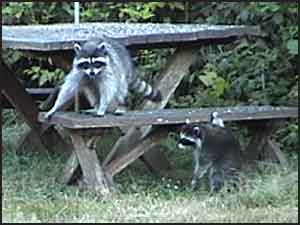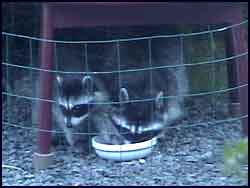Raccoons
Raccoon Video Clips

Lewis & Clark first noted the Common Raccoon (Procyon lotor) on June 13, 1804, near the Chariton River, Missouri. The name, raccoon, is derived from an Algonquin Indian word, aroughcoune, which means "he scratches with his hands."
Raccoon Description
Native to the Americas, these mammals are medium-sized with a ringed tail. Their tail is ringed with four to ten rings. The fur can vary between gray, brown and reddish black. They typically weigh 12 to 35 pounds. Because they have a black mask, they are often called "bandits."
As very accomplished climbers, they are able to climb any size tree forward or backward or even headfirst down a tree. Not many animals can descend headfirst down a tree. The reason raccoons can go headfirst down a tree is because they can rotate their hind feet 180 degrees.
Dexterous & Nibble
Even though they are not able to fold their thumbs across their palms as humans can, their five fingered paws are extremely dexterous. Their nimble fingers can open garbage cans, jars, lids and latches, turn doorknobs and open refrigerators.
As camphosts, we witnessed a raccoon reaction between two campers. As we were doing our morning check, we noticed a rift going on between the owner of a "banditized" cooler and neighboring camper because their bacon was removed from the cooler. They were surprised to hear that it was raccoons and shocked that evening when they witnessed the action.
Fun Nature Facts, comments on the dexterity of raccoons. "Who has not enjoyed watching the antics of a raccoon? What stands out first to even the casual observer, is the raccoons hands and nimble fingers. A raccoon's hands are so nimble that they can remove a coin as thin as a dime out of a shirt pocket, without even bending its fingers. Not only that, they are capable of removing several dimes at a time and hold them individually between its fingers. How's that for dexterity?"
The Washer
The Common Raccoon, Procyon lotor, is regularly associated with washing their food. Their latin name, lotor, means "the washer." Originally, it was believed that raccoons washed their hands because they didn't have salivary glands and needed the extra water in order to swallow the food. This theory has been disproved. The present theory is they are squashing or pressing the food to make sure there are no sharp bones or bits in the food before eating it.

Raccoons feel their food with their hands before eating it. In the picture above, the baby raccoon is feeling inside the dish for pieces of rolled oats. As they are feeling for food, they are looking elsewhere. Their sensitive hands are being used as an extra set of eyes. You can watch a video of them picking up pieces of oats with their dexterous hands. In the video, you can also hear them talking with each other.
As omnivores, they have a varied diet. National Wildlife's site, enature.com, writes, "the Common Raccoon eats grapes, nuts, berries, pawpaw, and black cherry; grubs, grasshoppers, and crickets; voles, deer mice, squirrels, and other small mammals; and bird eggs and nestlings. It spends most nights foraging along streams and may raid Common Muskrat houses to eat the young and to prey on rice rats nesting in the muskrat's walls (afterward perhaps taking the house as its den). The raccoon swims in woodland streams, prowling for crayfish, frogs, worms, fish, dragonfly larvae, clams, turtles, and turtle eggs; climbs trees to cut or knock down acorns; and, in residential areas, tips over or climbs into garbage cans."
Tracks
Except for man, raccoon tracks are the most distinctive of any mammal. They are plantigrade which mean they walk on the soles of their feet like humans and bears. The tracks of their front feet look similar to tiny human hands. You can see their tracks and read some entertaining personal stories at Bear Tracker.
Habitat & Reproduction
Raccoons have adapted to their loss of natural habitat by man. They prefer making leaf nests in large hollow trees; however, they also use man-made structures such as attics and chimneys, culverts, and any other area they can find for their dens. They don't hibernate, they just "sleep in" for long periods of time. They can sleep for a couple of weeks.
In the spring, young kits are born. Like cats, they play around the nesting area for 6 to 8 weeks. When it's time, the mother takes them by the nape of the neck outside the den area to explore the natural world. By late summer they are weaned. The young disperse in the fall although sometimes, they might stay with the mother until next spring when the mother drives them out because she is expecting a new litter. When den areas are large enough, communal denning can occur. The largest communal den contained 23 raccoons with only one male.
Orphan Raccoons
In an article, All About Raccoons, the Wildlife In Need Center in Oconomowoc, Wisconsin writes,
Educating the public is crucial in order to reduce the number of needless orphans created. Often raccoon mothers are trapped in attics, chimneys, boats and other human habitations that have not been adequately sealed off. Removal or destruction of the mother leaves hungry, crying babies to be dealt with.
Love 'em or not, they are members of our ecosystem that have adapted well to development. Perhaps their masks are their way of stealing back from people the land that was once theirs for foraging.
Raccoon Reading
For more information on raccoons, check out Animal Diversity.
